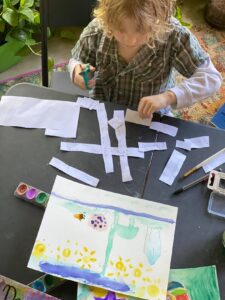 Example at Step 3: Ethan
Example at Step 3: Ethan
Here’s Ethan, who’s being homeschooled by a very intuitive and capable mother who discovered Key Words in the spring of Ethan’s kindergarten year.
Now three months later, he’s at Step 3. He’s dictated a 3-sentence story, and he’s now cutting the sentences apart so he can scramble them up — all 3 sentences together. Then he’ll mix up and reassemble them a couple of times, reading all three again each time. (If he needs help, he can use the back of his word card, where his mother has written the sentences for him.)
Ethan was already starting to write when he began working his way through The Steps. But he’s still working at Step 3, because by reassembling sentences he’s dictated for his mother to write, then working with them in this way, he’s actually developing the skills that go into “cold reading.”
Working in this way, he’ll learn to recognize many “sight words” for reading/writing. He’ll also be continuing to develop a solid foundation in phonics. For he’ll always be helping to spell the Key Word he’s asked for –and some of the words in his sentences.
Step 3 is so full of reading skills that I like to keep a child here as long as they’re happy doing it. (Check the criteria to decide when it’s too soon to move a child on.)
He says writing is fun now and writes on his own at other times during the day — without a Key Word. For we only allow a child to ask for ONE Key Word a day. (Although recall that a Key Word can actually be as many as 3 words, as in “chocolate ice cream.”)
When writing on his own, he asks his mother to help him sound out what he needs to spell a word he doesn’t already know and has trouble figuring out. (See Phonics With Key Words for a more elaborate treatment of phonics and spelling. It’s a procedure I developed for my K-2 classroom that’s very useful in the classroom and could be modified for home use — but is not absolutely necessary.)